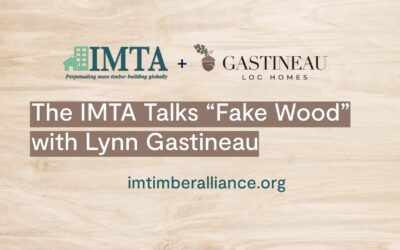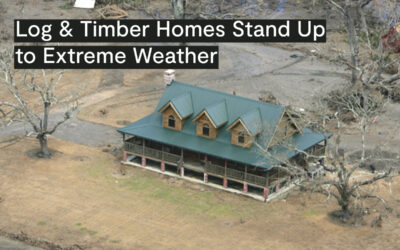Log homes typically aren’t the first thing that comes to mind when you think of fire safety. But research and real-world testing tell a very different story. Log walls, thanks to their mass and natural charring properties, perform surprisingly well in a fire, sometimes even better than conventional framed walls.
We break it down to—
- Why log homes hold up the way they do.
- What building codes require.
- And what this means for those designing, building, or living in a log home.
Why Fire Safety Matters in Log & Timber Construction
Concerns about fire safety aren’t new to the log and timber industry, but with beetle kill and rising temperatures and fires sneaking into the suburbs like the Marshall Fire in December of 2021 in Superior, Colorado, they’re becoming more frequent and hitting areas that weren’t typically thought of as fire-prone.
When it comes to the fire resistance of homes, the question isn’t just how quickly it ignites, but how long it can maintain its integrity so you can escape and firefighters can respond. That’s where the design and materials of log homes shine.
Fire Behavior 101—and Why Logs Are Different
A fire doesn’t destroy a building instantly; it goes through phases:
- Smoldering phase – Smoke forms and heat builds gradually.
- Flame and flashover – Within minutes of open flame, temperatures spike above 1,000°F.
- Fully developed fire – This stage can last for hours unless suppressed.
During each of these stages, the size and arrangement of combustible materials—known as the fuel array—make a difference. Small particles, such as sawdust, ignite almost instantly. Logs, on the other hand, due to their large mass and solidity, are much harder to ignite and burn more slowly.
What Happens When Wood Burns?
We’ve all sat around a campfire. Yes, wood is organic and combustible, but it has a natural defense mechanism: charring.
When exposed to fire, the outer layer of a log turns to a black char, creating an insulating barrier that slows further combustion. While structural steel loses half its strength at about 1,000°F, the core of a log behind the char layer remains surprisingly strong.
The American Wood Council notes a typical char rate of about 1.5 inches per hour. Even after significant fire exposure, the interior wood retains load-bearing capacity. This is why log walls often remain standing strong.
What the Research Shows
Research and testing back it up. Here are a few highlights:
- Scribe-fit log wall: In a controlled ISO 834 furnace test, a 10-inch-thick fully-scribed chinkless log wall endured temperatures exceeding 2,000°F on the fire side while the cool side stayed below 120°F. It maintained structural integrity for 172 minutes and passed insulation and integrity criteria for 180 minutes—that’s three hours of fire resistance without collapsing.
- Chinked log wall: A wall built with 9-inch Lodgepole pine logs and sealed with Log Jam™ chinking reached a one-hour fire rating per ASTM E-119 standards.
- Field observations and additional lab tests: Multiple studies, including those reviewed by the Log & Timber Homes Council, show that thicker logs—6 inches or more—typically provide at least a one-hour rating without added protection like drywall.
These numbers are far better than many expect and outperform standard light-frame walls without gypsum board.
Fire Codes and Compliance for Log and Timber Buildings: What You Need to Know
Modern building codes recognize the unique fire performance of logs. ICC 400—the standard for log structures—outlines three paths to compliance:
- Prescriptive: Logs with a minimum thickness of 6 inches meet a one-hour rating.
- Calculated: Use the National Design Specification (NDS) formula to account for char depth and remaining section strength.
- Tested: ASTM E-119 or equivalent full-scale fire tests confirm ratings for specific assemblies.
This flexibility allows builders and code officials to choose the most practical approach while maintaining safety standards.
Designing with Fire Resistance of Logs in Mind
Design decisions matter when it comes to log and timber buildings. Here are some best practices to follow:
- Go big: Thicker logs increase fire resistance.
- Seal smart: Proper joint sealing reduces air leaks and fire spread. Mineral wool insulation in grooves can act as a thermal shield.
- Plan openings: Windows and doors should use tempered or multi-layer glass for better resistance.
- Mind the roof: Choose Class A or B roof coverings, and protect overhangs and gutters with noncombustible materials.
- Defensible space: Follow the International Wildland-Urban Interface Code (IWUIC) guidelines—clear vegetation within 30 to 100 feet, depending on hazard level.
- Install alarms: Working smoke detectors and suppression systems remain the most effective life-safety measures.
Log Homes Surprisingly Fire Resistant
Log homes aren’t just beautiful and timeless—they’re surprisingly tough under fire conditions. Choosing the right design, materials, and taking safety measures, a log building can even outperform conventional construction.
Want to learn more? Read up. Below are the resources we used to research and write this article, as well as to educate ourselves.
Fire Performance of Log Homes, Prepared by the Construction Codes & Standards Committee, Log & Timber Homes Council, Building Systems Councils, National Association of Home Builders © 2001, 2002, 2003, 2008, 2021
Fire Resistance of Handcrafted Log Walls by Dalibor Houdek and Vladimir Bahyl
Log Building News, September 2001 Edition, International Log Builders Association
You Might Also Like…
The IMTA Talks “Fake Wood” with Lynn Gastineau
Lynn Gastineau, from Gastineau Log Homes, discussed the proliferation of “fake wood” products at the 2025 International Builders’ Show.
Lynn gives us some background on how she got into the log home industry, working in the sawmill with her dad. She shares her passion for solid wood building—how timber absorbs carbon and should be part of sustainable building practices, versus the energy consumption it takes to create “fake wood.”
Plus, the practical advantages of solid wood products include refinishing and durability.
Log and Timber Homes Stand Up to Extreme Weather
Log and timber homes stand up to extreme weather and natural disasters. There are several examples of log and timber homes escaping extreme weather and natural disasters unscathed while the neighborhood around them was demolished.



